Considering Farmers’ Heterogeneity to Payment Ecosystem Services Participation: A Choice Experiment and Agent-Based Model Analysis in Xin’an River Basin, China
Abstract
:1. Introduction
2. Methods
2.1. The Study Areas and Sampling
2.2. Elicitation of Farmers’ Preferences
2.3. Choice Experiment Framework
2.4. Agent-Based Model (ABM) Analysis
3. Results and Discussion
3.1. Descriptive Statistics
3.2. Choice Experiment Estimation
3.2.1. RPL Model
3.2.2. WTA Estimations
3.3. ABM Estimation
4. Discussions, Conclusions and Policy Implications
4.1. Discussions
4.2. Conclusions
4.3. Policy Implications
Supplementary Materials
Author Contributions
Funding
Institutional Review Board Statement
Informed Consent Statement
Data Availability Statement
Acknowledgments
Conflicts of Interest
References
- Gao, X.; Shen, J.; He, W.; Sun, F.; Zhang, Z.; Guo, W.; Zhang, X.; Kong, Y. An evolutionary game analysis of governments’ decision-making behaviors and factors influencing watershed ecological compensation in China. J. Environ. Manag. 2019, 251, 1990. [Google Scholar] [CrossRef]
- Lee, J.; Kweon, B.S.; Ellis, C.D.; Lee, S.W. Assessing the Social Value of Ecosystem Services for Resilient Riparian Greenway Planning and Management in an Urban Community. Int. J. Environ. Res. Public Health 2020, 17, 3261. [Google Scholar] [CrossRef]
- Plutino, M.; Bianchetto, E.; Durazzo, A.; Lucarini, M.; Lucini, L.; Negri, I. Rethinking the Connections between Ecosystem Services, Pollinators, Pollution and Health: Focus on Air Pollution and Its Impacts. Int. J. Environ. Res. Public Health 2022, 19, 2997. [Google Scholar] [CrossRef]
- Kang, M.J.; Siry, J.P.; Colson, G.; Ferreira, S. Do forest property characteristics reveal landowners’ willingness to accept payments for ecosystem services contracts in southeast Georgia, US? Ecol. Econ. 2019, 161, 144–152. [Google Scholar] [CrossRef]
- Alarcon, G.G.; Fantini, A.C.; Salvador, C.H.; Farley, J. Additionality is in detail: Farmers’ choices regarding payment for ecosystem services programs in the Atlantic forest, Brazil. J. Rural. Stud. 2017, 54, 177–186. [Google Scholar] [CrossRef]
- Wang, X.; Adamowski, J.F.; Wang, G.; Cao, J.; Zhu, G.; Zhou, J.; Liu, C.; Dong, X. Farmers’ Willingness to Accept Compensation to Maintain the Benefits of Urban Forests. Forests 2019, 10, 691. [Google Scholar] [CrossRef]
- Li, T.; Zhang, Q.; Zhang, Y. Modelling a Compensation Standard for a Regional Forest Ecosystem: A Case Study in Yanqing District, Beijing, China. Int. J. Environ. Res. Public Health 2018, 15, 565. [Google Scholar] [CrossRef]
- Getzner, M.; Islam, M.S. Ecosystem Services of Mangrove Forests: Results of a Meta-Analysis of Economic Values. Int. J. Environ. Res. Public Health 2020, 17, 5830. [Google Scholar] [CrossRef]
- Li, X.; Liu, W.; Yan, Y.; Fan, G.; Zhao, M. Rural Households’ Willingness to Accept Compensation Standards for Controlling Agricultural Non-Point Source Pollution: A Case Study of the Qinba Water Source Area in Northwest China. Water 2019, 11, 1251. [Google Scholar] [CrossRef]
- Zheng, W.; Ke, X.; Zhou, T.; Yang, B. Trade-offs between cropland quality and ecosystem services of marginal compensated cropland–A case study in Wuhan, China. Ecol. Indic. 2019, 105, 613–620. [Google Scholar] [CrossRef]
- Wang, L.; Zheng, W.; Tang, L.; Zhang, S.; Liu, Y.; Ke, X. Spatial optimization of urban land and cropland based on land production capacity to balance cropland protection and ecological conservation. J. Environ. Manag. 2021, 285, 112054. [Google Scholar] [CrossRef] [PubMed]
- Li, X.; Chen, Y. Projecting the future impacts of China’s cropland balance policy on ecosystem services under the shared socioeconomic pathways. J. Clean. Prod. 2020, 250, 119489. [Google Scholar] [CrossRef]
- Lu, Y.; Kong, F.; Huang, L.; Xiong, K.; Xu, C.; Wang, B. Evaluation of the Implementation Effect of the Ecological Compensation Policy in the Poyang Lake River Basin Based on Difference-in-Difference Method. Sustainability 2021, 13, 8667. [Google Scholar] [CrossRef]
- Zhang, Z.; Gao, J.; Fan, X.; Lan, Y.; Zhao, M. Response of ecosystem services to socioeconomic development in the Yangtze River Basin, China. Ecol. Indic. 2017, 72, 481–493. [Google Scholar] [CrossRef]
- Gao, X.; Shen, J.; He, W.; Sun, F.; Zhang, Z.; Zhang, X.; Yuan, L.; An, M. Multilevel Governments’ Decision-Making Process and Its Influencing Factors in Watershed Ecological Compensation. Sustainability 2019, 11, 1990. [Google Scholar] [CrossRef]
- Costanza, R.; Arge, R.; Groot, R.D.; Farberk, S.; Belt, M. The value of the world’s ecosystem services and natural capital. Nature 1997, 387, 253–260. [Google Scholar] [CrossRef]
- Millennium Ecosystem Assessment. Ecosystems and Human Well-Being: Synthesis; Island Press: Washington, DC, USA, 2005. [Google Scholar]
- De Groot, R.; Brander, L.; van der Ploeg, S.; Costanza, R.; Bernard, F.; Braat, L.; Christie, M.; Crossman, N.; Ghermandi, A.; Hein, L.; et al. Global estimates of the value of ecosystems and their services in monetary units. Ecosyst. Serv. 2012, 1, 50–61. [Google Scholar] [CrossRef]
- Lara-Pulido, J.A.; Guevara-Sanginés, A.; Arias Martelo, C. A meta-analysis of economic valuation of ecosystem services in Mexico. Ecosyst. Serv. 2018, 31, 126–141. [Google Scholar] [CrossRef]
- Grima, N.; Singh, S.J.; Smetschka, B.; Ringhofer, L. Payment for Ecosystem Services (PES) in Latin America: Analysing the performance of 40 case studies. Ecosyst. Serv. 2016, 17, 24–32. [Google Scholar] [CrossRef]
- Lurie, S.; Bennett, D.E.; Duncan, S.; Gosnell, H.; Hunter, M.L.; Morzillo, A.T.; Moseley, C.; Nielsen-Pincus, M.; Parker, R.; White, E.M. PES marketplace development at the local scale: The Eugene Water and Electric Board as a local watershed services marketplace driver. Ecosyst. Serv. 2013, 6, 93–103. [Google Scholar] [CrossRef]
- Ren, Y.; Lu, L.; Zhang, H.; Chen, H.; Zhu, D. Residents’ willingness to pay for ecosystem services and its influencing factors: A study of the Xin’an River basin. J. Clean. Prod. 2020, 268, 122301. [Google Scholar] [CrossRef]
- Yu, B.; Chen, L. Interventional Impacts of Watershed Ecological Compensation on Regional Economic Differences: Evidence from Xin’an River, China. Int. J. Environ. Res. Public Health 2020, 17, 6389. [Google Scholar] [CrossRef] [PubMed]
- Dong, J.; Wu, D. An Evaluation of the Impact of Ecological Compensation on the Cross-Section Efficiency Using SFA and DEA: A Case Study of Xin’an River Basin. Sustainability 2020, 12, 7966. [Google Scholar] [CrossRef]
- Le, W.; Leshan, J. How eco-compensation contribute to poverty reduction: A perspective from different income group of rural households in Guizhou, China. J. Clean. Prod. 2020, 275, 122962. [Google Scholar] [CrossRef]
- Lyu, R.; Clarke, K.C.; Zhang, J.; Feng, J.; Jia, X.; Li, J. Dynamics of spatial relationships among ecosystem services and their determinants: Implications for land use system reform in Northwestern China. Land Use Policy 2021, 102, 105231. [Google Scholar] [CrossRef]
- Pfaff, A.; Rodriguez, L.A.; Shapiro-Garza, E. Collective Local Payments for ecosystem services: New local PES between groups, sanctions and prior watershed trust in Mexico. Water Resour. Econ. 2019, 28, 100136. [Google Scholar] [CrossRef]
- Bremer, L.L.; Farley, K.A.; Lopez-Carr, D. What factors influence participation in payment for ecosystem services programs? An evaluation of Ecuador’s SocioPáramo program. Land Use Policy 2014, 36, 122–133. [Google Scholar] [CrossRef]
- Kwayu, E.J.; Sallu, S.M.; Paavola, J. Farmer participation in the equitable payments for watershed services in Morogoro, Tanzania. Ecosyst. Serv. 2014, 7, 1–9. [Google Scholar] [CrossRef]
- Osiolo, H.H. Willingness to pay for improved energy: Evidence from Kenya. Renew. Energy 2017, 112, 104–112. [Google Scholar] [CrossRef]
- Mahieu, P.A.; Riera, P.; Giergiczny, M. The influence of cheap talk on willingness-to-pay ranges: Some empirical evidence from a contingent valuation study. J. Environ. Plan. Manag. 2012, 55, 753–763. [Google Scholar] [CrossRef]
- Bisung, E.; Elliott, S.J.; Schuster-Wallace, C.J.; Karanja, D.M.; Bernard, A. Social capital, collective action and access to water in rural Kenya. Soc. Sci. Med. 2014, 119, 147–154. [Google Scholar] [CrossRef] [PubMed]
- Chen, C.; Matzdorf, B.; Zhen, L.; Schröter, B. Social-Network Analysis of local governance models for China’s eco-compensation program. Ecosyst. Serv. 2020, 45, 101191. [Google Scholar] [CrossRef]
- Brownson, K.; Guinessey, E.; Carranza, M.; Esquivel, M.; Hesselbach, H.; Madrid Ramirez, L.; Villa, L. Community-Based Payments for Ecosystem Services (CB-PES): Implications of community involvement for program outcomes. Ecosyst. Serv. 2019, 39, 100974. [Google Scholar] [CrossRef]
- Olson, M. The Logic of Collective Action: Public Goods and The Theory of Groups. Soc. Forces 1973, 52, 123–125. [Google Scholar]
- Fairhead, J.; Leach, M.; Scoones, I. Green Grabbing: A new appropriation of nature? J. Peasant Stud. 2012, 39, 237–261. [Google Scholar] [CrossRef]
- McGinnis, I.; Atallah, S.S.; Huang, J.C. Households’ preferences for hydrological services in Veracruz, Mexico: The importance of outcomes vs. program design. J. Environ. Manag. 2021, 300, 113763. [Google Scholar] [CrossRef]
- Villamayor-Tomas, S.; Sagebiel, J.; Rommel, J.; Olschewski, R. Types of collective action problems and farmers’ willingness to accept agri-environmental schemes in Switzerland. Ecosyst. Serv. 2021, 50, 101304. [Google Scholar] [CrossRef]
- Bocci, C.; Sohngen, B.; Lupi, F.; Milian, B. Timber or carbon? Evaluating forest conservation strategies through a discrete choice experiment. Ecol. Econ. 2020, 171, 106601. [Google Scholar] [CrossRef]
- Chaikaew, P.; Hodges, A.W.; Grunwald, S. Estimating the value of ecosystem services in a mixed-use watershed: A choice experiment approach. Ecosyst. Serv. 2017, 23, 228–237. [Google Scholar] [CrossRef]
- Bougherara, D.; Lapierre, M.; Préget, R.; Sauquet, A. Do farmers prefer increasing, decreasing, or stable payments in Agri-environmental schemes? Ecol. Econ. 2021, 183, 106946. [Google Scholar] [CrossRef]
- Zhang, T.; Meng, T.; Hou, Y.; Huang, X.; Oenema, O. Which policy is preferred by crop farmers when replacing synthetic fertilizers by manure? A choice experiment in China. Resour. Conserv. Recycl. 2022, 180, 106176. [Google Scholar] [CrossRef]
- Geussens, K.; Van den Broeck, G.; Vanderhaegen, K.; Verbist, B.; Maertens, M. Farmers’ perspectives on payments for ecosystem services in Uganda. Land Use Policy 2019, 84, 316–327. [Google Scholar] [CrossRef]
- Lence, S.H.; Singerman, A. When does voluntary coordination work? Evidence from area-wide pest management. Am. J. Agr. Econ. 2022, 1–22. [Google Scholar] [CrossRef]
- Ostrom, E. Analyzing collective action. Agric. Econ. 2010, 41, 155–166. [Google Scholar] [CrossRef]
- Zhang, Q.; Sannigrahi, S.; Bilintoh, T.M.; Zhang, R.; Xiong, B.; Tao, S.; Bilsborrow, R.; Song, C. Understanding human-environment interrelationships under constrained land-use decisions with a spatially explicit agent-based model. Anthropocene 2022, 38, 100337. [Google Scholar] [CrossRef]
- Haile, K.K.; Tirivayi, N.; Tesfaye, W. Farmers’ willingness to accept payments for ecosystem services on agricultural land: The case of climate-smart agroforestry in Ethiopia. Ecosyst. Serv. 2019, 39, 100964. [Google Scholar] [CrossRef]
- Schulze, J.; Müller, B.; Groeneveld, J.; Grimm, V. Agent-Based Modelling of Social-Ecological Systems: Achievements, Challenges and a Way Forward. J. Artif. Soc. Soc. Simul. 2017, 20, 3423. [Google Scholar] [CrossRef]
- Wang, Y.; Zhang, Q.; Li, Q.; Wang, J.; Sannigrahi, S.; Bilsborrow, R.; Bellingrath-Kimura, S.D.; Li, J.; Song, C. Role of social networks in building household livelihood resilience under payments for ecosystem services programs in a poor rural community in China. J. Rural Stud. 2021, 86, 208–225. [Google Scholar] [CrossRef]
- Burg, V.; Troitzsch, K.G.; Akyol, D.; Baier, U.; Hellweg, S.; Thees, O. Farmer’s willingness to adopt private and collective biogas facilities: An agent-based modeling approach. Resour. Conserv. Recycl. 2021, 167, 105400. [Google Scholar] [CrossRef]
- Wang, Y.; Zhang, Q.; Sannigrahi, S.; Li, Q.; Tao, S.; Bilsborrow, R.; Li, J.; Song, C. Understanding the Effects of China’s Agro-Environmental Policies on Rural Households’ Labor and Land Allocation with a Spatially Explicit Agent-Based Model. J. Artif. Soc. Soc. Simul. 2021, 24, 4589. [Google Scholar] [CrossRef]
- Filatova, T.; Polhill, J.G.; van Ewijk, S. Regime shifts in coupled socio-environmental systems: Review of modelling challenges and approaches. Environ. Modell. Softw. 2016, 75, 333–347. [Google Scholar] [CrossRef]
- Heckbert, S.; Baynes, T.; Reeson, A. Agent-based modeling in ecological economics. Ann. N.Y. Acad. Sci. 2010, 1185, 39–53. [Google Scholar] [CrossRef]
- Walsh, S.J.; Mean, C.F. Perspectives for the Study of the Galapagos Islands: Complex Systems and Human-Environment Interactions. In Science and Conservation in the Galapagos Islands; Springer: New York, NY, USA, 2013; pp. 49–67. [Google Scholar]
- Cheng, Y.; Wu, D.; Bian, Y. A systematic approach of determining compensation and allocation for river basin water environment based on total pollutants control. J. Environ. Manag. 2020, 271, 110896. [Google Scholar] [CrossRef] [PubMed]
- Chèze, B.; David, M.; Martinet, V. Understanding farmers’ reluctance to reduce pesticide use: A choice experiment. Ecol. Econ. 2020, 167, 106349. [Google Scholar] [CrossRef]
- Krah, K.; Michelson, H.; Perge, E.; Jindal, R. Constraints to adopting soil fertility management practices in Malawi: A choice experiment approach. World Dev. 2019, 124, 104651. [Google Scholar] [CrossRef]
- Christensen, T.; Pedersen, A.B.; Nielsen, H.O.; Mørkbak, M.R.; Hasler, B.; Denver, S. Determinants of farmers’ willingness to participate in subsidy schemes for pesticide-free buffer zones—A choice experiment study. Ecol. Econ. 2011, 70, 1558–1564. [Google Scholar] [CrossRef]
- Lancaster, K.J. A New Approach to Consumer Theory. J. Political Econ. 1966, 74, 132–157. [Google Scholar] [CrossRef]
- McFadden, D. Conditional logit analysis of qualitative choice behavior. In Frontiers of Econometrics; Zarembka, P.E., Ed.; Academic Press: New York, NY, USA, 1973. [Google Scholar]
- Kotu, B.H.; Oyinbo, O.; Hoeschle-Zeledon, I.; Nurudeen, A.R.; Kizito, F.; Boyubie, B. Smallholder farmers’ preferences for sustainable intensification attributes in maize production: Evidence from Ghana. World Dev. 2022, 152, 105789. [Google Scholar] [CrossRef]
- Van den Berg, P.; Weijs-Perree, M.; Dane, G.; van Vliet, E.; Liu, H.; Sun, S.; Borgers, A. A Comparative Study of Urban Park Preferences in China and The Netherlands. Int. J. Environ. Res. Public Health 2022, 19, 4632. [Google Scholar] [CrossRef]
- Tadesse, T.; Berhane, T.; Mulatu, D.W.; Rannestad, M.M. Willingness to accept compensation for afromontane forest ecosystems conservation. Land Use Policy 2021, 105, 105382. [Google Scholar] [CrossRef]
- Rindfuss, R.R.; Entwisle, B.; Walsh, S.J.; An, L.; Badenoch, N.; Brown, D.G.; Deadman, P.; Evans, T.P.; Fox, J.; Geoghegan, J.; et al. Land use change: Complexity and comparisons. J. Land Use Sci. 2008, 3, 1–10. [Google Scholar] [CrossRef] [PubMed]
- Huber, R.; Xiong, H.; Keller, K.; Finger, R. Bridging behavioural factors and standard bio-economic modelling in an agent-based modelling framework. J. Agric. Econ. 2021, 73, 35–63. [Google Scholar] [CrossRef]
- Maes, D.; Passel, S.V. An agent-based model of farmer behaviour to explain the limited adaptability of Flemish agriculture. Environ. Innov. Soc. Trans. 2017, 22, 63–77. [Google Scholar] [CrossRef]
- Müller, B.; Bohn, F.; Dreßler, G.; Groeneveld, J.; Klassert, C.; Martin, R.; Schlüter, M.; Schulze, J.; Weise, H.; Schwarz, N. Describing human decisions in agent-based models—ODD + D, an extension of the ODD protocol. Environ. Modell. Softw. 2013, 48, 37–48. [Google Scholar] [CrossRef]
- Grimm, V.; Berger, U.; Bastiansen, F.; Eliassen, S.; Ginot, V.; Giske, J.; Goss-Custard, J.; Grand, T.; Heinz, S.K.; Huse, G.; et al. A standard protocol for describing individual-based and agent-based models. Ecol. Model. 2006, 198, 115–126. [Google Scholar] [CrossRef]
- Grimm, V.; Berger, U.; DeAngelis, D.L.; Polhill, J.G.; Giske, J.; Railsback, S.F. The ODD protocol: A review and first update. Ecol. Model. 2010, 221, 2760–2768. [Google Scholar] [CrossRef]
- Grimm, V.; Railsback, S.F.; Vincenot, C.E.; Berger, U.; Gallagher, C.; DeAngelis, D.L.; Edmonds, B.; Ge, J.; Giske, J.; Groeneveld, J.; et al. The ODD Protocol for Describing Agent-Based and Other Simulation Models: A Second Update to Improve Clarity, Replication and Structural Realism. J. Artif. Soc. Soc. Simul. 2020, 23, 7. [Google Scholar] [CrossRef]
- Gołębiowska, B.; Bartczak, A.; Budziński, W. Impact of social comparison on preferences for Demand Side Management in Poland. Energy Policy 2021, 149, 112024. [Google Scholar] [CrossRef]
- Kanchanaroek, Y.; Aslam, U. Policy schemes for the transition to sustainable agriculture—Farmer preferences and spatial heterogeneity in northern Thailand. Land Use Policy 2018, 78, 227–235. [Google Scholar] [CrossRef]
- Simon, H.A. Rational choice and the structure of the environment. Psychol. Rev. 1956, 63, 129–138. [Google Scholar] [CrossRef]
- Tversky, K.A. Prospect Theory: An Analysis of Decision under Risk. Econometrica 1979, 47, 263–291. [Google Scholar]
- Ni, Q.; Cai, Y.; Xu, T.; Zhao, M. ‘What if I feel it is mine?’—The impact of psychological ownership on public participation in China’s transboundary watershed eco-compensation. Water Policy 2021, 23, 700–717. [Google Scholar] [CrossRef]
- Wang, X.; Bennett, J.; Xie, C.; Zhang, Z.; Liang, D. Estimating non-market environmental benefits of the Conversion of Cropland to Forest and Grassland Program: A choice modeling approach. Ecol. Econ. 2007, 63, 114–125. [Google Scholar] [CrossRef]
- Brouwer, R.; Martin-Ortega, J.; Berbel, J. Spatial preference heterogeneity: A choice experiment. Land Econ. 2010, 86, 552–568. [Google Scholar] [CrossRef]
- Etchart, N.; Freire, J.L.; Holland, M.B.; Jones, K.W.; Naughton-Treves, L. What happens when the money runs out? Forest outcomes and equity concerns following Ecuador’s suspension of conservation payments. World Dev. 2020, 136, 105124. [Google Scholar] [CrossRef]
- Zanella, M.A.; Schleyer, C.; Speelman, S. Why do farmers join Payments for Ecosystem Services (PES) schemes? An Assessment of PES water scheme participation in Brazil. Ecol. Econ. 2014, 105, 166–176. [Google Scholar] [CrossRef]
- Corbera, E.; Pascual, U. Ecosystem services: Heed social goals. Science 2012, 335, 655–656. [Google Scholar] [CrossRef]
- Hecken, G.V.; Bastiaensen, J. Payments for Ecosystem Services in Nicaragua: Do Market-based Approaches Work? Dev. Change 2010, 41, 421–444. [Google Scholar] [CrossRef]
- Groeneveld, J.; Mueller, B.; Buchmann, C.M.; Dressler, G.; Guo, C.; Hase, N.; Hoffmann, F.; John, F.; Klassert, C.; Lauf, T. Theoretical foundations of human decision-making in agent-based land use models—A review. Environ. Model. Softw. 2017, 87, 39–48. [Google Scholar] [CrossRef]
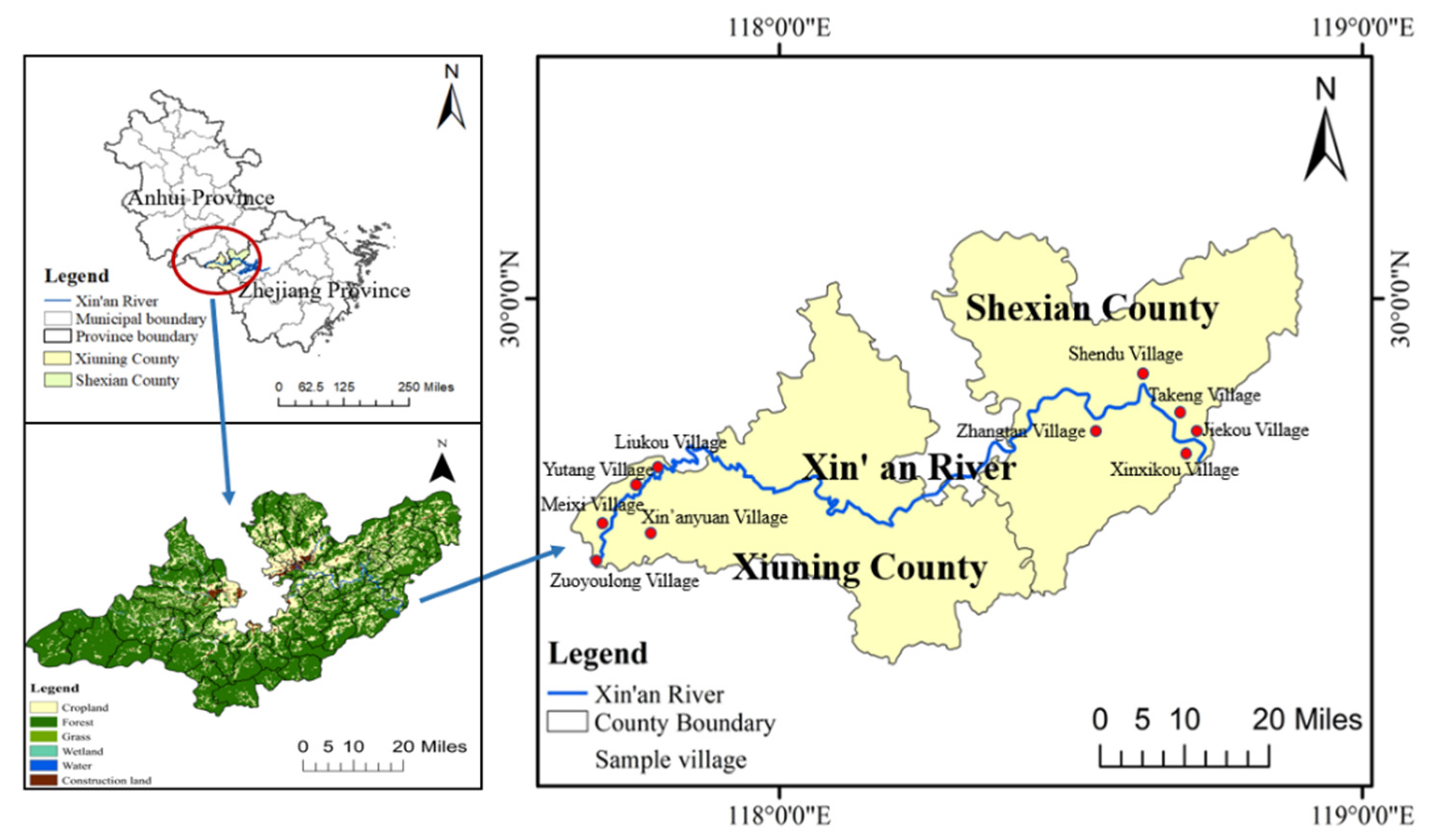

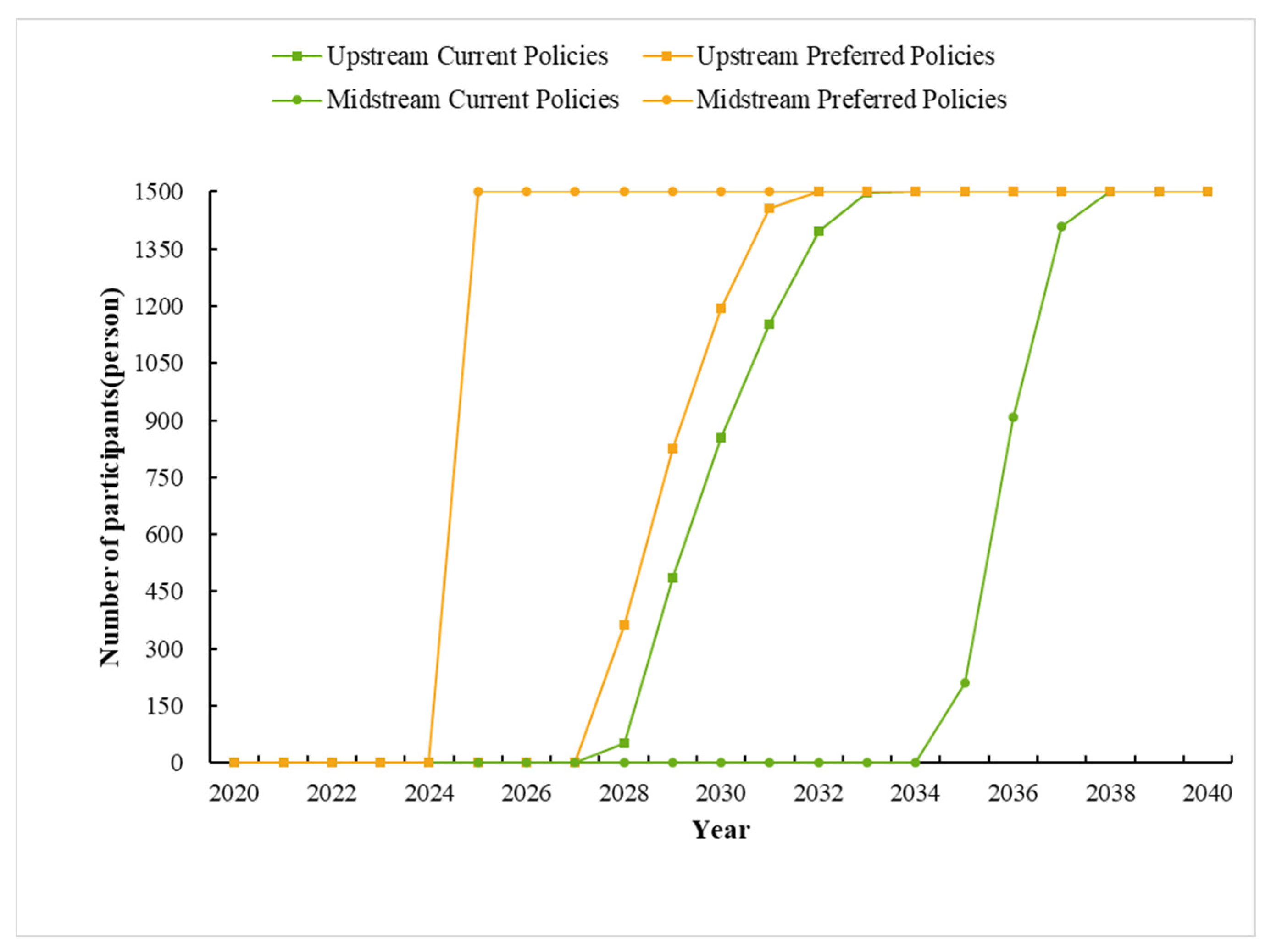
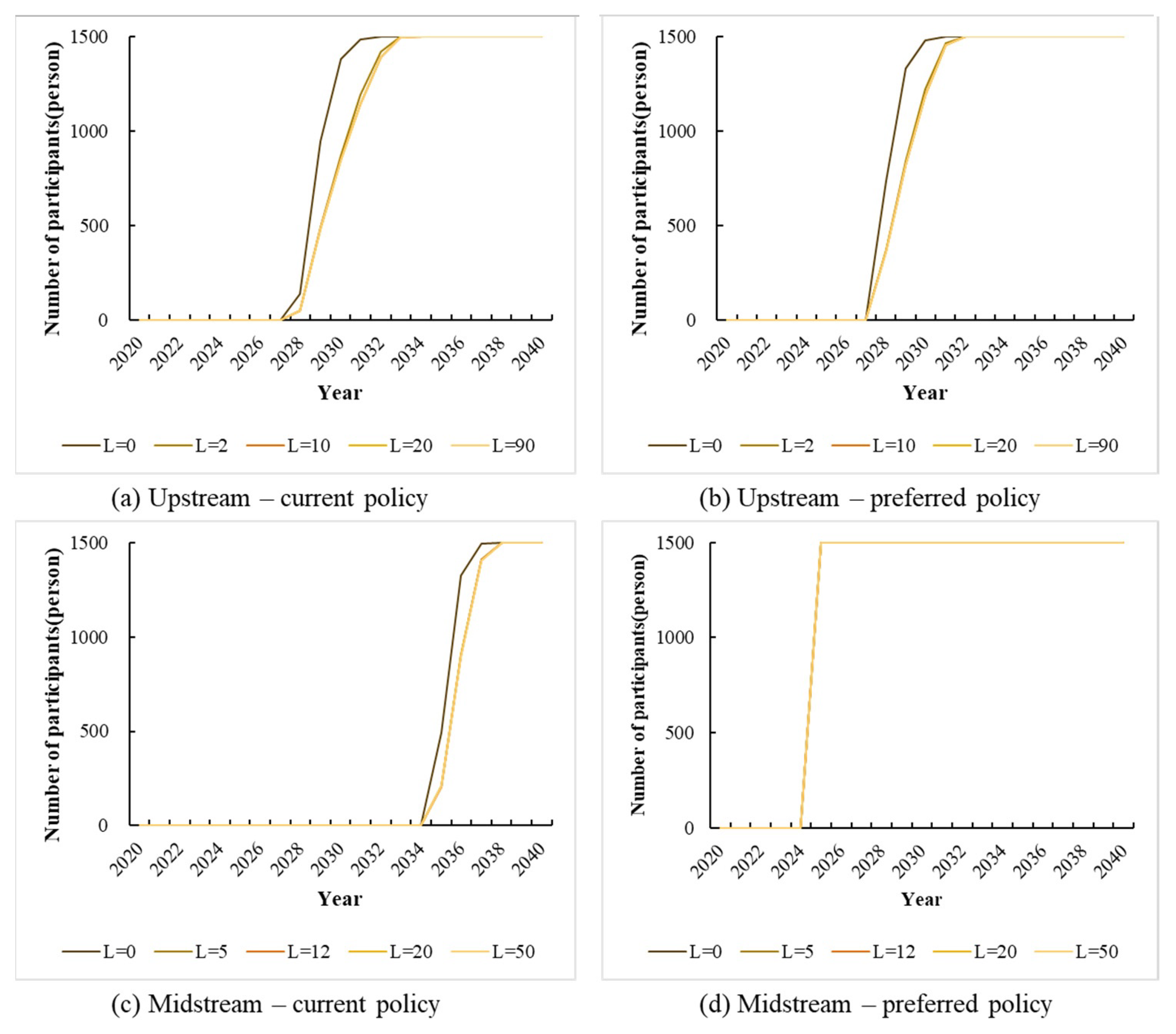
| Attributes | Levels |
|---|---|
| Livestock and poultry breeding | total prohibition = 1; rationalization = 0 |
| Agricultural water quality | grade I = 1; grade II = 0 |
| Agricultural waste recycling rate | 75%; 80%; 85%; 90% |
| Compensation years | 3 years; 5 years; 7 years; 9 years |
| Cash requirement | 25 RMB/month; 50 RMB/month; 75 RMB/month |
| Attributes | Alternative A | Alternative B | Alternative C |
|---|---|---|---|
| Livestock and poultry breeding | total prohibition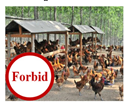 | total prohibition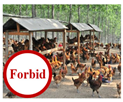 | Neither alternative A, nor B. I would maintain current farm management |
| Agricultural water quality | water quality grade II | water quality grade I | |
| Agricultural waste recycling rate | 80%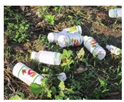 | 75%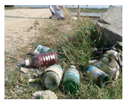 | |
| Compensation years | 7 years | 7 years | |
| Cash requirement /month | 75 yuan/month | 50 yuan/month |
| Variables | Description | Total | Upstream | Midstream | Difference in Means |
|---|---|---|---|---|---|
| Mean (SD) | Mean (SD) | Mean (SD) | |||
| Gender | Gender | 0.04 | |||
| (Male = 1; Female = 0) | 0.62 | 1.40 | 1.36 | ||
| (0.49) | (0.49) | (0.48) | |||
| Age | Age | 61.33 (10.67) | 61.38 (12.09) | 61.29 (9.33) | 0.08 *** |
| Education | Education years(year) | 6.91 (3.62) | 5.48 (3.96) | 8.08 (2.80) | −2.60 *** |
| Number of laborers | Number of household labor force | 2.94 (1.41) | 3.30 (1.51) | 2.64 (1.23) | 0.66 ** |
| Forest land area | Forest land area (ha) | 1.02 (2.05) | 1.97 (2.77) | 0.24 (0.30) | 1.72 *** |
| Forest land slope | Slope of forest land (Gentle = 1; Generally steep = 2; Steep = 3) | 1.94 (0.60) | 1.99 (0.62) | 1.90 (0.57) | 0.09 |
| Distance from residence to river | Distance from the living house to Xin’an River(m) | 248.48 (239.50) | 116.87 (127.30) | 355.41 (254.94) | −238.54 *** |
| Distance from forest land to river | Distance from the forest land to the Xin’an River(m) | 304.48 (447.81) | 223.21 (356.12) | 370.35 (499.73) | 147.14 *** |
| Social network | Numbers of farmers with mutual working relations | 15.78 (31.65) | 14.25 (16.03) | 17.02 (40.11) | −2.77 |
| RPL Model | RPL Model with Interaction | ||||
|---|---|---|---|---|---|
| Model 1 | Model 2 | Model 3 | Model 4 | ||
| Upstream | Midstream | Upstream | Midstream | ||
| Variables | Coefficient (Str. Error) | Coefficient (Str. Error) | Coefficient (Str. Error) | Coefficient (Str. Error) | |
| ASC | −6.609 ** (2.670) | 1.752 *** (0.466) | 0.288 (2.005) | 1.208 (1.775) | |
| Agricultural water quality | Mean | −1.956 (1.250) | −0.838 *** (0.305) | −0.636 (0.496) | −1.571 ** (0.670) |
| Standard deviation | 6.093 * (3.139) | 0.735 (1.029) | 1.691 * (0.997) | 3.138 * (1.722) | |
| Compensation years | Mean | 0.530 ** (0.262) | 0.148 ** (0.065) | 0.391 *** (0.109) | 0.168 *** (0.061) |
| Standard deviation | 1.662 (1.042) | 0.612 ** (0.308) | 0.834 *** (0.256) | 0.263 (0.288) | |
| Livestock and poultry breeding | −6.447 ** (2.572) | −1.572 *** (0.489) | −4.484 *** (1.143) | −2.213 *** (0.748) | |
| Agricultural waste recycling rate | −13.065 (8.614) | −7.592 (4.642) | −8.047 * (4.394) | −5.513 (4.488) | |
| Cash requirement | 0.112 ** (0.044) | 0.059 *** (0.013) | 0.081 *** (0.020) | 0.063 *** (0.014) | |
| ASC × Gender | −0.469 (0.598) | 1.119 *** (0.427) | |||
| ASC × Age | −0.057 ** (0.024) | 0.024 (0.022) | |||
| ASC × Education | −0.064 (0.074) | 0.142 * (0.078) | |||
| ASC × Number of laborers | −0.099 (0.171) | −0.348 ** (0.157) | |||
| ASC × Forestland area | −0.848 *** (0.262) | 0.033 (0.582) | |||
| ASC × Forestland slope | −0.126 (0.418) | −0.327 (0.332) | |||
| ASC × Distance from residence to river | −0.001 (0.002) | −0.0002 (0.001) | |||
| ASC × Distance from forestland to river | 0.003 *** (0.001) | 0.466 (0.0004) | |||
| Obs | 1170 | 1440 | 1170 | 1440 | |
| Log likelihood | −352.514 | −471.811 | −305.029 | −460.116 | |
| AIC | 723.0 | 961.6 | 660.1 | 970.2 | |
| R2 | 0.175 | 0.105 | 0.286 | 0.127 | |
| RPL Model | RPL Model with Interaction | |||
|---|---|---|---|---|
| Model 1 | Model 2 | Model 3 | Model 4 | |
| Attributes | Upstream | Midstream | Upstream | Midstream |
| Agricultural water quality | (0) (−2.5, 176.2) | 14.20 (2.8, 43.5) | (0) (−2.8, 37.4) | 24.94 (2.8, 80.1) |
| Compensation years | −4.73 (−5.3, −0.6) | −2.51 (−3.2, −0.6) | −4.83 (−5.1, 4.1) | −2.67 (−2.8, −1.4) |
| Livestock and poultry breeding | 57.56 (7.1, 459.6) | 26.64 (7.2, 76.7) | 55.36 (18.8, 156.5) | 35.13 (8.3, 102.2) |
| Agricultural waste recycling rate | (0) (−19.2, 1198.0) | (0) (−17.8,505.8) | 99.35 (−4.8, 387.4) | (0) (−36.4, 397.5) |
| Total | 52.83 (−19.9, 1833.1) | 38.33 (−10.9, 625.3) | 149.88 (6.1, 577.3) | 57.40 (−28.1, 578.4) |
Publisher’s Note: MDPI stays neutral with regard to jurisdictional claims in published maps and institutional affiliations. |
© 2022 by the authors. Licensee MDPI, Basel, Switzerland. This article is an open access article distributed under the terms and conditions of the Creative Commons Attribution (CC BY) license (https://creativecommons.org/licenses/by/4.0/).
Share and Cite
Li, S.; Hui, B.; Jin, C.; Liu, X.; Xu, F.; Su, C.; Li, T. Considering Farmers’ Heterogeneity to Payment Ecosystem Services Participation: A Choice Experiment and Agent-Based Model Analysis in Xin’an River Basin, China. Int. J. Environ. Res. Public Health 2022, 19, 7190. https://doi.org/10.3390/ijerph19127190
Li S, Hui B, Jin C, Liu X, Xu F, Su C, Li T. Considering Farmers’ Heterogeneity to Payment Ecosystem Services Participation: A Choice Experiment and Agent-Based Model Analysis in Xin’an River Basin, China. International Journal of Environmental Research and Public Health. 2022; 19(12):7190. https://doi.org/10.3390/ijerph19127190
Chicago/Turabian StyleLi, Shengnan, Baohang Hui, Cai Jin, Xuehan Liu, Fan Xu, Chong Su, and Tan Li. 2022. "Considering Farmers’ Heterogeneity to Payment Ecosystem Services Participation: A Choice Experiment and Agent-Based Model Analysis in Xin’an River Basin, China" International Journal of Environmental Research and Public Health 19, no. 12: 7190. https://doi.org/10.3390/ijerph19127190
APA StyleLi, S., Hui, B., Jin, C., Liu, X., Xu, F., Su, C., & Li, T. (2022). Considering Farmers’ Heterogeneity to Payment Ecosystem Services Participation: A Choice Experiment and Agent-Based Model Analysis in Xin’an River Basin, China. International Journal of Environmental Research and Public Health, 19(12), 7190. https://doi.org/10.3390/ijerph19127190





